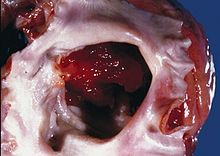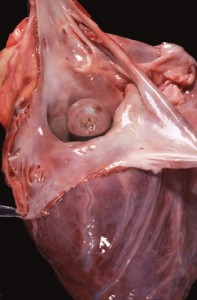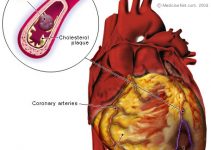Myxoma is a benign jelly-like tumor of the heart that affects patients aging 30-60 years of age and often leads to heart attack. Get detailed information about the disease, including its causes, symptoms, diagnosis and treatment.
Myxoma Definition
Page Contents
It is an uncommon intra-cardiac tumor (or a tumor that is present inside the heart). The left atrial myxoma constitutes 75% of all the occurring myxomas while the right atrial myxoma represents the remaining 25%. Such new growth of tissue is usually a soft irregular shaped jellylike accumulation or a round firm gathering of mass.
These tumors are linked with endocardium, the inner lining of the cardiac. The cells which comprise of the myxoma tumor are spindle-shaped and are rooted in an environment made up of mucopolysaccharides. Such abnormal growth of tissues is also termed as Atrial myxoma.
Myxoma ICD9 Code
The ICD9 code for this medical condition is 212.7.
Myxoma Incidence
Cardiac Myxoma is considered to be the one of the most common non-malignant tumors affecting the heart. In a few cases, this disorder occurs due to hereditary reasons and affects young individuals. This condition is more prevalent among women and normally affects individuals above the age of 40.
Myxoma Types
Soft tissue myxoma can be differentiated into 9 types:
Picture 1 – Myxoma
Intramuscular myxoma
It is a non-cancerous soft tissue tumor found in the skeletal muscle. Such disorders lack particular symptoms and hence diagnosis of such tumors is quite difficult.
Aggressive angiomyxoma
It is an uncommon lump of mesenchymal mass which develops in the vulvovaginal and perineum region. The tumor is infiltrative in nature and is associated with local recurrence.
Superficial acral fibromyxoma
It is a rare soft tissue neoplasm which is generally found on the hands and feet of adults. This disorder originates from CD34+ fibroblasts and has a predilection for the subungal or periungal regions.
Cutaneous myxoma
It is an infrequent tumor of the subcutis and skin. Such tumors occur among patients suffering from Carney’s syndrome and are more common among men than women, typically middle aged adults.
Juxta-articular myxoma
This form of Myxoma affects the large joints followed by shoulder, ankle and hip. Older patients, with a medical history of osteoarthritis, are more prone to such tumors. Such tumors range between 2- 6 cm in size and generally occur in the knee joints of aged adults.
Angiomyofibroblastoma
It is an uncommon myofibroblastic tumor made up of soft tissues, that normally occurs among females aged 25-50. The tumors are circumscribed round shaped mass that and originate from CD34.
Nerve Sheath Myxoma
Such neoplasm is form of nerve sheath tumor and affects both adults and children. Such tumors have a predilection for the limbs and knees and are generally 2.5 cm in diameter.
Pseudo Myxoma Peritonei
It is a medical condition which occurs due to the production of excess mucin by tumor cells. It fills the abdominal cavity and constricts the liver, kidney and pancreas if left untreated.
Myxoma Causes
Myxoma tumors do not arise due to any causative agents. Atrial myxoma tumors are the result of multipotential mesenchymal cells and may lead to a ball valve-type barrier. Almost 10% of such patients acquire such tumors due to hereditary reasons.
Myxoma Symptoms
The symptoms related with ventricular myxoma arise due to tumor which restricts the usual flow of blood inside the heart chambers. Atrial myxoma symptoms generally occur when the affected patient lies in a specific position. The warning signs of the disorder may be related with the discharge of interleukin by the tumor. The classic signs of the disease may include:
- Breathing problem, especially during the upright position
- Dizziness
- Palpitations
- Sudden death
- Shortness of breath during any physical activity
- Paroxysmal nocturnal dyspnea
- Fainting
- Chest pain
Additional symptoms
Patients affected with such tumors display a number of general symptoms, including:
- Fever
- General discomfort
- Bluishness of the skin
- Clubbing
- Swelling of any of the body part
- Cough
- Cachexia
- Joint pain
- Sensitive fingers, changing colors with cold or stress
Myxoma Diagnosis
The diagnosis of myxoma tumor initiates with the study of the medical history and proper physical examination of the patient. Generally, the physical examination of individuals affected with Atrial myxoma is normal. Ventilation perfusion lung scan should be conducted to rule out the possibility of pulmonary embolism as the primary cause of the disorder. Physical findings may include inspection of the heart to find out the existence of any classic tumor. To confirm the diagnosis of Atrial myxoma, doctors recommend a few diagnostic tests which include:
- Blood electrolytes
- Cardiac enzymes
- Pulse oximetry
- Troponin levels
- Coagulation profile
- Chest x-ray
- Echocardiogram
- Thyroid profile
- Electrocardiogram (EKG or ECG)
- Cardiac monitoring
- Thallium heart scan
- Cardiac catheterization
Myxoma Differential Diagnosis
The differential diagnosis of the disease involves distinguishing its symptoms from those of other medical conditions that include:
- Pulmonary Embolism
- Pulmonary Hypertension, Primary
- Tricuspid Regurgitation
- Mitral Regurgitation
- Mitral Stenosis
- Tricuspid Stenosis
Such tumors which occur inside the heart are not pedunculated in nature and can penetrate inside the muscle of the heart. Such cardiac tumors can be diagnosed with Magnetic Resonance Imaging (MRI).
Myxoma Treatment
According to medical practitioners, these tumors should be removed from the atrium via surgery. If the surgery is not conducted by an expert surgeon, Myxoma tumor may reoccur. After surgery, doctors advise patients to undergo echocardiography for the next 5 years in order to make sure that such lumps do not arise again.
Myxoma Prognosis
Although myxoma tumor is benign in nature, it displays a number of complications. If left untreated, such masses can give rise to embolism (breaking of the tumors cells and moving with the blood). These can restrict the flow of blood or can even cause the tumor cells to develop in a different part of the body. The fragments of the tumor cells can travel to the eye, brain or even limbs. Growth of the tumor inside the heart can restrict the flow of blood via the mitral valve and give rise to various indicators of mitral stenosis. Immediate surgery may be required to save the life of a patient.
Myxoma Complications
If left untreated, such tumors can give rise to a series of complications including:
Picture 2 – Myxoma Image
- Peripheral emboli
- Spread (metastasis) of the tumor
- Arrhythmias
- Pulmonary edema
- Blockage of the mitral heart valve
Myxoma is benign disorder, occurring inside the heart muscles of individuals in the form of tumors. Do not neglect the syndrome, for it can give rise to series of medical complications. If you or any of your family members is experiencing the symptoms of the disease, consult your health care provider immediately.
References:
http://health.nytimes.com/health/guides/disease/atrial-myxoma/overview.html
http://en.wikipedia.org/wiki/Myxoma
http://medical-dictionary.thefreedictionary.com/myxoma
http://www.freemd.com/myxoma/outlook.htm



